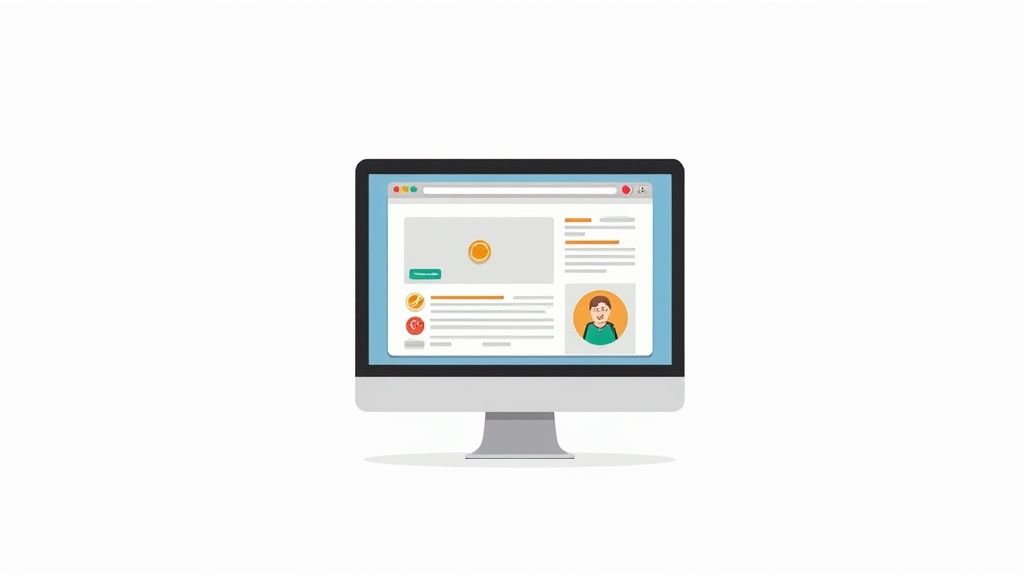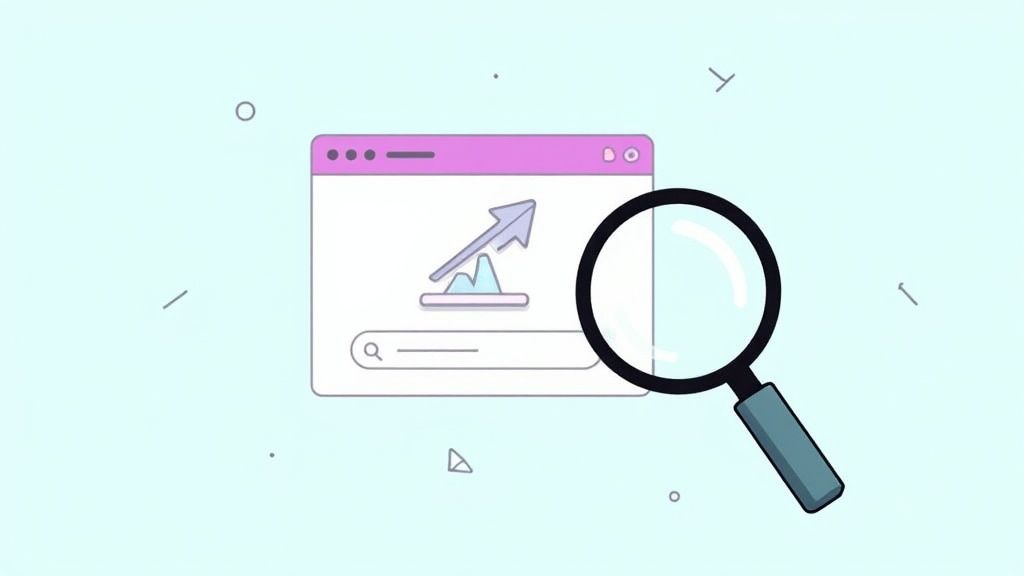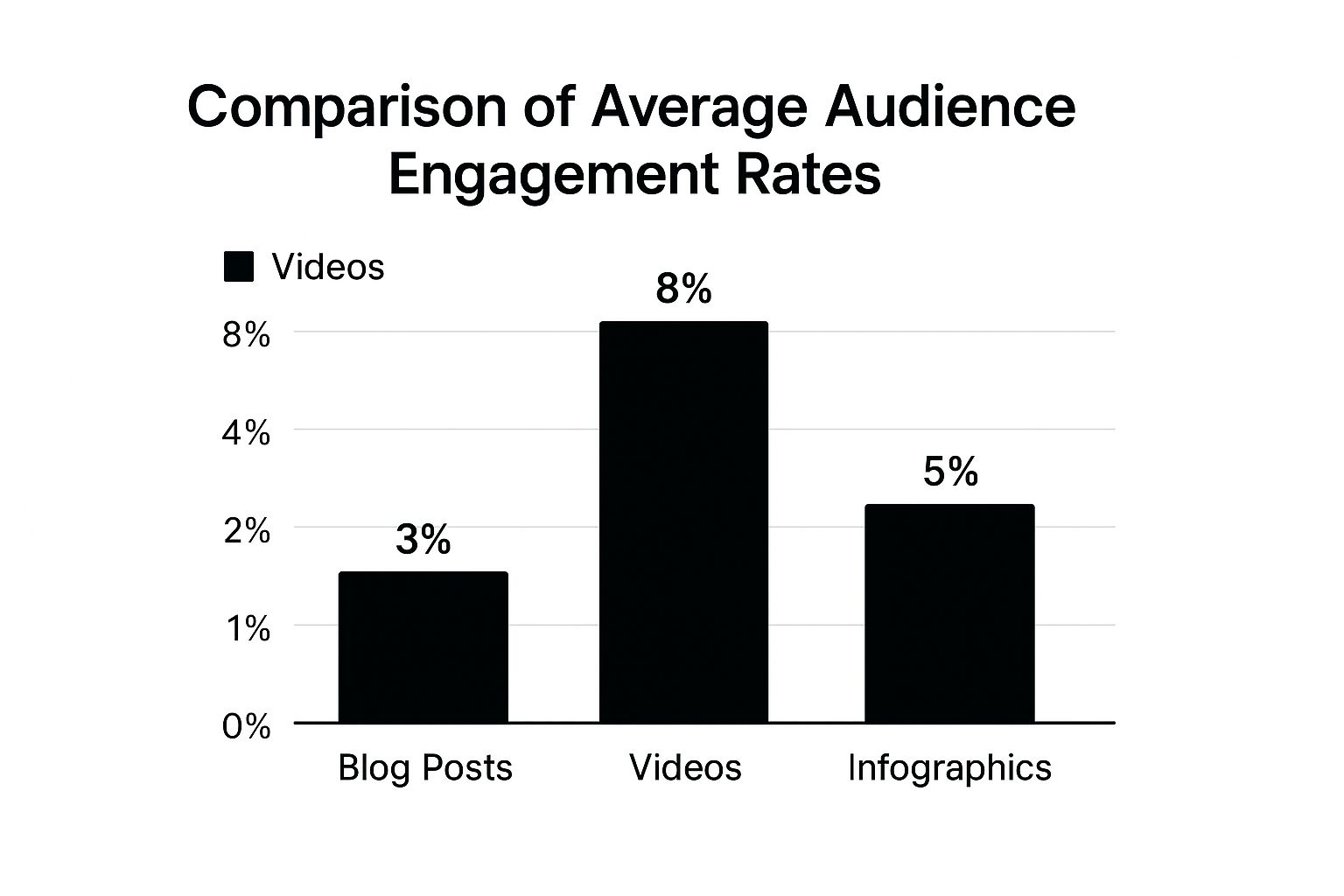How to Grow Your Business Online: Top Strategies for Success

If you want to grow your business online, you need to think beyond just one channel. The goal is to build a complete, sustainable digital ecosystem. This means having a high-performing website, mastering search engine optimization (SEO) to pull in the right kind of traffic, creating genuinely valuable content, and connecting with your audience on social media. These aren't just separate tasks; they work together to create a strong foundation for real, lasting success.
Building Your Digital Foundation for Growth

Expanding your business online isn't about jumping on every new trend or trying out the latest shiny tool. It’s about building a solid, interconnected foundation where every piece supports the others. Think of it like building a house. You wouldn't start hanging expensive art on the walls before making sure the foundation is solid and secure, right?
It's the same idea here. Pouring money into ads before your website is optimized and ready for visitors is a fast way to waste your budget. A strong digital foundation ensures that every single dollar you invest in marketing has the best possible chance to deliver a return. This means getting the non-negotiables right from the start.
Understanding Your Core Pillars
The journey to grow your business online really comes down to four fundamental pillars. When you get each one right, you build a powerful engine that not only attracts new customers but also keeps them coming back. If you neglect any one of these, you're leaving a major hole in your strategy, which makes any kind of sustainable growth incredibly difficult.
These are the foundational elements you absolutely have to nail:
- Your Website: This is your digital headquarters, the central hub for all your online activity. It needs to be fast, user-friendly, and built to turn visitors into customers.
- Search Engine Optimization (SEO): This is how you show up on Google when people are actively searching for the exact solutions you offer. It's about being visible at the moment of need.
- Content Marketing: This is all about creating and sharing helpful content—like blog posts, videos, or detailed guides—that solves your audience’s problems and builds unshakable trust in your brand.
- Social Media: This is where you build a community. It’s your chance to engage with your audience in a real way, have conversations, and drive people back to your website.
The Competitive Digital Marketplace
The need to build a strong online presence has never been more urgent. The digital marketplace is crowded, and it's only getting more competitive. In fact, estimates suggest there will be over 28 million active e-commerce stores worldwide by 2025. That's a massive 27% jump from pre-pandemic levels, all thanks to platforms making it easier than ever to sell online. You can explore the data on e-commerce business trends to see just how much the space has grown.
In an environment this competitive, the old "build it and they will come" mindset is a surefire way to fail. Success demands a deliberate, strategic plan built on a robust digital foundation that helps you rise above the noise.
To help you visualize how these pieces fit together, I've put together a table breaking down these core pillars. It outlines what each one is for and where you need to focus your efforts.
Core Pillars of Online Business Growth
| Growth Pillar | Primary Business Objective | Key Focus Areas |
|---|---|---|
| High-Performing Website | Convert visitors into leads or customers | Site speed, mobile-friendliness, user experience (UX), clear calls-to-action (CTAs) |
| Search Engine Optimization | Drive targeted organic traffic | Keyword research, on-page optimization, technical SEO, link building |
| Content Marketing | Build authority, trust, and audience engagement | Blog posts, video tutorials, case studies, pillar content creation |
| Social Media & Community | Foster brand loyalty and direct communication | Platform selection, consistent engagement, community management, user-generated content |
By truly understanding how these elements connect, you can move from a scattershot approach to a cohesive, powerful strategy. This guide will walk you through exactly what to do for each pillar, turning these concepts into a practical roadmap for achieving genuine, measurable online growth.
Mastering SEO to Attract Eager Customers

So, you've built a website. That’s a great first step, but it's not enough to just exist online—you need people to actually find you. This is where search engine optimization (SEO) comes into play, and it’s your most powerful tool for getting discovered.
Think of SEO as the bridge connecting you to customers right when they’re looking for what you offer. It's less about ticking a box and more about the art of showing up on Google at the perfect moment.
The opportunity here is massive. The number of digital buyers worldwide is projected to hit 2.77 billion by 2025. On top of that, experts predict e-commerce will make up 22.6% of all global retail sales by 2027. A huge chunk of your audience is online, searching for solutions, making a solid SEO strategy non-negotiable for growth.
Decoding Customer Intent with Keyword Research
Before you do anything else, you have to get inside your customer's head. What are they actually typing into that search bar? This is what we call keyword research, and it’s about a lot more than just guessing.
Let's say you own a shop selling handmade leather goods. Targeting a broad keyword like "leather bags" is a fast track to getting lost in a sea of massive competitors. You'll get much better results by focusing on a specific, long-tail keyword like "handmade leather tote bag in Austin."
Why? Because it reveals serious buying intent. That searcher isn’t just browsing; they know what they want and are likely ready to make a purchase.
Your goal is to uncover keywords that signal different stages of the customer journey:
- Informational Keywords: "how to clean a leather wallet"
- Navigational Keywords: "artisan leather shop near me"
- Transactional Keywords: "buy custom leather journal online"
When you target these specific phrases, you can create content that provides the exact answers your audience is looking for, positioning your business as the go-to solution.
Optimizing Your On-Page and Technical SEO
Once you know the what (your keywords), it’s time to focus on the where—your website. This is where we dive into two crucial parts of SEO: on-page and technical.
On-page SEO is everything you can see and control directly on your web pages. This includes your page titles, headers, the content itself, and even the alt text on your images. Every element should be woven together with your target keywords to send a clear message to search engines about what your page is about.
My favorite analogy: Think of your website as a library. On-page SEO is like giving every book a clear title and organizing them on the right shelves. It helps both people and search engines find exactly what they need, fast.
Technical SEO, on the other hand, is all the stuff happening behind the scenes. It’s the nuts and bolts that make your site run smoothly. Key factors include:
- Site Speed: How fast do your pages load?
- Mobile-Friendliness: Does your site work well on a phone?
- Site Architecture: Is your site logically structured and easy to navigate?
A slow, clunky, or broken website is a dead end for users. It also signals to Google that your site offers a poor experience, which can tank your rankings in a hurry.
Building Authority and Trust Over Time
Finally, remember that SEO isn't a one-and-done task. It's a long-term play focused on building trust and authority in your niche. You achieve this by consistently creating high-quality, genuinely helpful content that people want to read and share.
When other credible websites link back to your content, it’s like a vote of confidence for search engines, boosting your site’s authority. This is where SEO and content marketing really start to overlap. To get a deeper understanding, I recommend checking out these content marketing best practices for 2025.
By getting these SEO fundamentals right, you'll build a reliable stream of high-intent traffic, pulling in customers who are actively looking for you and setting your business up for sustainable, long-term growth.
Creating Content That Actually Converts

Once you've got your SEO foundation in place, it's time to build the engine that drives your long-term growth. That engine is content. But I'm not talking about just churning out random blog posts or half-hearted social media updates. We're talking about creating strategic, valuable assets that do more than just attract eyeballs—they turn visitors into loyal customers.
Think of effective content marketing as the bridge between grabbing someone's attention and convincing them to take the next step. It’s how you prove you know your stuff, solve your audience's real-world problems, and build relationships based on trust, not just transactions. This is where you truly connect with your audience on a deeper level.
Moving Beyond Random Acts of Content
So many businesses fall into the "random acts of content" trap. A blog post here, a social update there, all with no clear strategy tying it all together. It feels productive, sure, but it almost never moves the needle in a meaningful way.
To see real growth, you have to shift your mindset. Stop thinking like a content creator and start thinking like a problem solver. Your goal isn't just to talk about your products; it's to create resources that help your ideal customer crush their biggest challenges. That’s how you earn their attention and, eventually, their trust.
For instance, a company selling project management software shouldn't just write posts about its features. A much better approach? Create a comprehensive guide on "How to Master Remote Team Workflows." This tackles a genuine pain point head-on and naturally positions their software as the perfect solution.
The Power of Pillar Content
One of the most powerful strategies I've seen for organizing content efforts is the pillar content model. A pillar post isn't just another article; it's a massive, in-depth piece that covers a core industry topic from top to bottom. Think of it as the ultimate, definitive guide on a subject your audience cares deeply about.
From this one huge pillar post, you can then create an entire ecosystem of smaller, related content pieces—a "topic cluster," as it's often called.
The real magic of pillar content is its efficiency. You invest heavily in creating one amazing resource, and then you can repurpose it endlessly across all your marketing channels, maximizing your return on that initial effort.
Let's say a B2B cybersecurity firm creates a pillar post called "The Ultimate Guide to Small Business Data Protection." From that single piece, they could spin off a ton of other content:
- Blog Posts: A whole series on topics like "Top 5 Password Managers," "How to Spot a Phishing Email," and "Building Your First Data Backup Plan."
- Social Media: Short video tips, infographics, and quick-hit checklists for LinkedIn and Twitter.
- Email Marketing: A five-day email course that guides subscribers through the essential steps of data protection.
- Video Content: A detailed YouTube tutorial walking viewers through setting up two-factor authentication on popular platforms.
This "create once, distribute many" approach keeps your message consistent and reaches your audience wherever they hang out, all without you having to constantly reinvent the wheel.
Choosing the Right Content Format for Your Audience
Not all content is created equal. The format you choose can make or break its effectiveness. While long-form blog posts are fantastic for SEO and showing off your expertise, other formats are better suited for different goals.
Your choice of format should really come down to two things: the specific topic you're covering and the platform you're publishing on.
| Content Format | Best Used For | Example Scenario |
|---|---|---|
| Blog Posts & Guides | Building SEO authority, providing in-depth solutions, and capturing search traffic. | A financial advisor writes a 3,000-word guide on "How to Create Your First Budget." |
| Video Tutorials | Demonstrating how a product works, teaching a process, or showing a physical technique. | A fitness coach creates a YouTube video showing the proper form for a deadlift. |
| Case Studies | Providing social proof, building trust, and showing real-world results for your service. | A marketing agency details how they helped a client increase their web traffic by 150%. |
| Checklists & Templates | Offering practical, immediately usable value that serves as a powerful lead magnet. | A web designer offers a downloadable "Website Launch Checklist" in exchange for an email. |
Ultimately, a winning content strategy uses a healthy mix of these formats. This keeps your audience engaged and ensures you’re delivering your message in the most impactful way for each channel. By focusing on solving problems and repurposing your best work, you’ll build a content machine that consistently turns strangers into customers.
Using Social Media and Email to Build a Loyal Community
While great content and solid SEO are fantastic for getting people to your digital doorstep, social media and email are how you invite them inside for a cup of coffee. This is where you stop broadcasting and start building real, lasting relationships.
Think of these channels as conversation starters, not just sales megaphones. It’s the shift in mindset that turns a one-time customer into a true fan who tells their friends about you.
Choosing the Right Platforms Intentionally
One of the biggest mistakes I see businesses make is trying to be everywhere at once. It’s a surefire way to stretch your team thin and get mediocre results across the board. The smarter move? Go where your audience already lives and breathes online.
For example, if you sell handmade jewelry, you belong on visually rich platforms like Instagram or Pinterest. High-quality photos, Reels showing your process—that’s what will resonate. But if you’re a B2B software company, you’ll get far more traction on LinkedIn, sharing industry insights and connecting with fellow professionals. We've got a detailed guide to help you build a winning LinkedIn content strategy if that’s your arena.
To figure this out, do some light detective work. Where do your ideal customers ask questions? Where do they share their passions? Show up there and become a valuable, contributing member of that community.
Fostering Genuine Engagement and Interaction
Once you’ve picked your platforms, the real work begins. Your goal is to spark conversations, not just rack up vanity metrics like 'likes'. This means creating content that actively pulls your audience in.
Here are a few ways to get real engagement going:
- Run interactive polls and quizzes. Ask for opinions on new product ideas or even just fun, industry-adjacent topics. It shows you value their voice.
- Showcase user-generated content (UGC). When a customer tags you in a post featuring your product, ask for permission to share it. This is incredibly powerful social proof and makes your customers feel like superstars.
- Pull back the curtain. Use Stories or short videos to show the people behind the brand. Introduce your team, share a messy part of the creative process, or just walk through a day in the office.
The brands that win on social media don't just talk at their followers; they talk with them. They ask questions, reply to comments, and create a genuine space for connection.
Building Deeper Connections with Email Marketing
Social media is fantastic for broad, public engagement, but email is where you nurture your most personal connections. It’s a direct line to your most dedicated followers, allowing you to send tailored messages that get results.
Learning how to build a winning email marketing campaign is just as crucial as your social strategy. The true magic of email lies in segmentation. Instead of blasting the same newsletter to everyone, you can create specific groups based on their behavior and interests.
Let’s take an online plant shop, for instance. They could easily segment their list like this:
| Audience Segment | Personalized Content Example |
|---|---|
| New Subscribers | A welcome series with beginner care tips and a first-purchase discount. |
| Past Buyers | Exclusive early access to new plant arrivals or guides for plants they own. |
| "Wishlist" Users | An alert when an item they saved is back in stock or on sale. |
This targeted approach makes your emails feel like a helpful note from a friend, not a sales pitch. It shows you’re paying attention, and that kind of value is what ultimately builds a rock-solid foundation of loyalty.
Scaling Growth with Smart Paid Advertising
Once your organic foundation is humming along, paid advertising is like pouring gasoline on the fire. It's a powerful accelerator. While your SEO and content marketing are busy building long-term trust, paid ads let you jump the line and get in front of your ideal customers right now.
This isn't about burning cash. It's about making smart, calculated investments to supercharge what you already know is working. Think of it as adding a turbocharger to your finely-tuned marketing engine. When done right, paid ads amplify your message, drive highly targeted traffic on demand, and deliver results you can measure almost immediately. The trick is to start small, target with laser precision, and let the data be your guide.
Your First Small-Budget Campaign
You don't need a huge budget to see a return from paid ads. In fact, starting small is the smartest way to learn the ropes without taking on unnecessary risk. The goal here is to launch a lean, focused campaign, gather some real-world data, and figure out what resonates with your audience before you start spending more.
Platforms like Google Ads and Meta Ads (which covers Facebook and Instagram) give you incredibly granular targeting options. This means you can show your ads to people based on their specific interests, demographics, online behaviors, and even whether they've visited your website before.
Here’s a simple framework to get started without overcomplicating things:
- Pick One Clear Goal: What's the single most important action you want someone to take? It could be signing up for a webinar, downloading an ebook, or making a purchase. Keep it simple.
- Target a Niche Audience: Don't go after "small business owners." That's too broad. Get specific, like "owners of Shopify stores with 1-10 employees who have shown interest in email marketing software." The more specific, the better your results.
- Set a Modest Daily Budget: Start with an amount you're comfortable "losing" as you learn. Think $10 or $20 per day. This is your "tuition fee" for gathering priceless performance data.
Let Analytics Drive Your Decisions
Here’s where the real magic happens. Paid advertising, when paired with sharp analytics, becomes a predictable growth machine. Without data, you're just gambling. Tools like Google Analytics are your command center, showing you exactly what people from your ad campaigns do once they land on your website.
You have to look past the vanity metrics like clicks and impressions. They feel good, but they don't pay the bills. Instead, focus on the numbers that directly impact your bottom line:
- Conversion Rate: What percentage of people who clicked your ad actually did the thing you wanted them to do?
- Cost Per Acquisition (CPA): How much did it cost, on average, to get one new customer or lead from your ad?
- Return on Ad Spend (ROAS): This is the big one. For every dollar you spent, how many dollars in revenue did you get back?
The market today demands this level of precision. The global ecommerce market is projected to reach a staggering $8.3 trillion by 2025, and with over 70% of online purchases now happening on mobile, you can't afford to waste your ad spend on the wrong audience.
Creating a Powerful Closed-Loop System
Let’s put this into a real-world scenario. Imagine you run a business that sells high-end kitchen gadgets. You're digging through your Google Analytics and notice that visitors coming from a specific food blog are converting at 3x the rate of any other traffic source. That's a golden nugget of information.
Instead of just crossing your fingers and hoping for more traffic from that blog, you can take control. You build a targeted ad campaign on Facebook specifically for people who follow that exact food blog and have also shown an interest in cooking. The ad itself showcases a gadget that was featured in one of the blog's most popular recipes.
This is what a closed-loop system looks like. You use analytics to spot what’s working organically, then you pour fuel on that fire with paid ads, targeting the opportunity with surgical precision. It’s a repeatable formula for profitable growth.
This infographic highlights how different types of content perform, which is incredibly useful for deciding what kind of creative to use in your ads.

As you can see, video often gets the highest engagement, making it a fantastic choice for ad campaigns on platforms like Facebook and Instagram. Paid advertising isn't just about buying traffic; it's about amplifying your wins. Combining ads with these powerful content promotion strategies will help you squeeze the most value out of every single dollar you spend.
Choosing the Right Advertising Platform
Picking the right platform is half the battle. Each has its own strengths and is suited for different goals. This table breaks down the most popular options to help you decide where to put your budget for the best results.
| Platform | Best For | Audience Intent | Typical Cost Structure |
|---|---|---|---|
| Google Ads | Capturing high-intent search traffic and targeting specific keywords. Excellent for lead generation and e-commerce sales. | Active Intent: Users are actively searching for a solution to their problem. | Pay-Per-Click (PPC) |
| Meta Ads (Facebook & Instagram) | Building brand awareness and reaching highly specific demographic and interest-based audiences. Great for visual products and services. | Passive Intent: Users are browsing, not actively searching. You interrupt them with a compelling ad. | Cost-Per-Mille (CPM) or PPC |
| LinkedIn Ads | B2B marketing, targeting professionals by job title, industry, company size, and other professional criteria. | Professional Intent: Users are in a business and career-oriented mindset. | PPC or CPM |
| Pinterest Ads | Reaching users who are in a planning and discovery mindset, especially for visual products in fashion, home decor, food, and DIY. | Discovery Intent: Users are looking for inspiration and ideas for future purchases. | PPC or CPM |
Ultimately, the best platform for you depends on who your customer is and where they spend their time online. It often makes sense to start with one platform, master it, and then expand to others as you grow. Don't try to be everywhere at once.
Got Questions About Growing Your Business Online?
Jumping into the world of online business growth opens up a ton of questions. You’ve got the basics down—SEO, content, social media, ads—but you’re probably wondering how it all fits together in the real world, especially when you're just getting your feet wet.
Let's tackle some of the most common hurdles I see business owners run into. I'll give you the straight-up, practical answers you need to make smart moves and start building real momentum.
How Long Does It Really Take to See SEO Results?
This is the million-dollar question, and the only honest answer is: it depends. SEO is a long game, not a lottery ticket. Generally, you can expect to see some real, meaningful movement and a noticeable bump in organic traffic within 6 to 12 months.
But that timeline can swing wildly based on a few key things:
- How Tough Your Niche Is: A local bakery will probably see results way faster than a national insurance agency. Why? The competition is just less intense.
- Your Website's History: If you have an established site with some history and a few links already pointing to it, you've got a head start. A brand-new domain is starting from scratch.
- Your Hustle: How consistently are you publishing genuinely helpful, optimized content? Are you actively trying to get backlinks? The more effort you put in here, the faster the needle will move.
Think of SEO like planting a tree. You have to water it and be patient before you get any shade, but the payoff is a sustainable, long-term asset that keeps on giving.
I Have a Tiny Budget. Where Should I Even Start?
When cash is tight, your biggest advantage is focus. Don't fall into the trap of trying to do a little bit of everything. You’ll just spread your resources too thin. Instead, pour your energy into the one or two channels that will give you the biggest bang for your buck.
For most new businesses, that usually means zeroing in on two areas:
- Content Marketing: You can't beat the ROI of creating solid blog posts that answer the exact questions your customers are Googling. It's incredibly cost-effective, builds your SEO foundation, and positions you as the go-to expert in your space.
- One Social Media Platform: Seriously, just one. Don't try to be on Instagram, TikTok, LinkedIn, Pinterest, and X all at once. Find out which single platform your ideal customers live on and commit to showing up and being genuinely engaged there.
The goal on a small budget isn't to be everywhere. It's to be unmissable where it counts. Get really good at one channel, build a loyal community, and then you can think about expanding once the revenue starts flowing.
Do I Really Need to Be on Every Single Social Media Platform?
Nope. Absolutely not. In fact, trying to manage a presence on every social media site is one of the fastest ways to burn out and get mediocre results across the board. It's the classic "jack of all trades, master of none" scenario.
A much smarter approach is to be deliberate. Ask yourself these questions:
- Where does my target audience actually hang out and interact with brands?
- Does the platform’s format even make sense for my business? (Visual products crush it on Instagram; B2B services belong on LinkedIn).
- Realistically, which platform can I commit to managing well without losing my mind?
For a deeper dive into expanding your digital footprint and more proven strategies for online business growth, there are some great resources out there. Focusing your energy is what allows you to create better content and build a real community on the few platforms that will actually move the needle for your business.
Ready to turn your content into visually stunning carousels that captivate your audience on social media? Lumeo makes it easy to create high-impact visual assets from your articles, tweets, or ideas in minutes. Start creating for free and see how engaging visuals can accelerate your online growth. Discover more at https://lumeo.me.